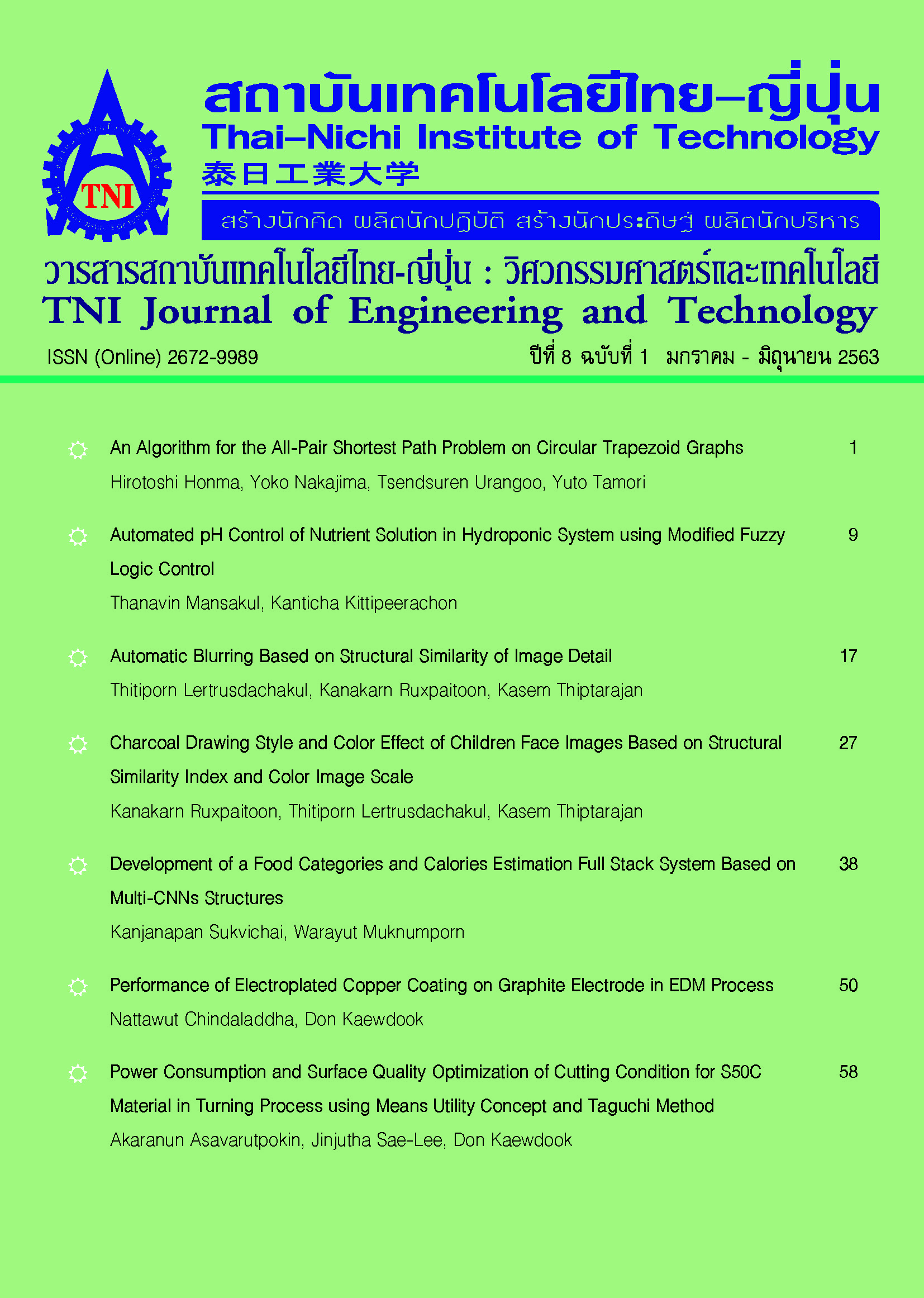การเบลอภาพอัตโนมัติด้วยการประมวลผล ความคล้ายคลึงของโครงสร้างรายละเอียดภาพ
Main Article Content
บทคัดย่อ
การเบลอภาพถูกนำมาใช้อย่างหลากหลายเพื่อการปรับปรุงภาพ เช่น แก้ไขจุดบกพร่อง สร้างการรับรู้หรือความรู้สึกต่อภาพ ดึงดูดความสนใจให้กับวัตถุ แต่เนื่องด้วยภาพมีรายละเอียดแตกต่างกัน จึงต้องการระดับความเบลอที่เหมาะสมกับเนื้อหาภาพและวัตถุประสงค์การใช้งาน งานวิจัยนี้จึงได้ศึกษาพัฒนาการเบลอเพื่อเพิ่มมิติ ความลึกให้กับภาพแบบอัตโนมัติ โดยแบ่งเป็นการเบลอแบบพื้นหลังละลายและแบบรักษาโครงร่างลวดลาย โดยใช้การประเมินคุณภาพภาพด้วยค่า Structural Similarity Index (SSIM) เฉพาะส่วนที่เป็นรายละเอียดภาพที่ส่งผลต่อการรับรู้ความเบลอของมนุษย์ เป็นตัววัดระดับความเบลอของภาพระหว่างกัน โดยใช้ค่าจุดเริ่มเปลี่ยน (Threshold) จากวิธีการของ Otsu เพื่อแยกพื้นที่ส่วนที่เป็นรายละเอียดภาพ และอ้างอิงเกณฑ์ค่าระดับความเบลอที่เหมาะสมจากผลการทดลองเบื้องต้น 100 ภาพ สร้างเป็นภาพผลลัพธ์ความเบลอทั้งสองระดับแบบอัตโนมัติ เพื่อใช้ในการสร้างความโดดเด่นให้กับจุดสนใจของภาพ ซึ่งจากผลประเมินโดยผู้เชี่ยวชาญด้านการถ่ายภาพพบว่า สามารถช่วยสร้างมิติให้กับภาพได้ดี ช่วยประหยัดเวลาในการปรับแต่งภาพโดยเฉพาะอย่างยิ่งสำหรับผู้ที่ไม่เชี่ยวชาญทางศิลปะ
Article Details
นโยบายการรับบทความ
กองบรรณาธิการวารสารสถาบันเทคโนโลยีไทย-ญี่ปุ่น มีความยินดีรับบทความจากอาจารย์ประจำ และผู้ทรงคุณวุฒิในสาขาวิศวกรรมศาสตร์และเทคโนโลยี ที่เขียนเป็นภาษาไทยหรือภาษาอังกฤษ ซึ่งผลงานวิชาการที่ส่งมาขอตีพิมพ์ต้องไม่เคยเผยแพร่ในสิ่งพิมพ์อื่นใดมาก่อน และต้องไม่อยู่ในระหว่างการพิจารณาของวารสารอื่นที่นำส่ง ดังนั้นผู้สนใจที่จะร่วมเผยแพร่ผลงานและความรู้ที่ศึกษามาสามารถนำส่งบทความได้ที่กองบรรณาธิการเพื่อเสนอต่อคณะกรรมการกลั่นกรองบทความพิจารณาจัดพิมพ์ในวารสารต่อไป ทั้งนี้บทความที่สามารถเผยแพร่ได้ประกอบด้วยบทความวิจัย ผู้สนใจสามารถศึกษาและจัดเตรียมบทความจากคำแนะนำสำหรับผู้เขียนบทความ
การละเมิดลิขสิทธิ์ถือเป็นความรับผิดชอบของผู้ส่งบทความโดยตรง บทความที่ได้รับการตีพิมพ์ต้องผ่านการพิจารณากลั่นกรองคุณภาพจากผู้ทรงคุณวุฒิและได้รับความเห็นชอบจากกองบรรณาธิการ
ข้อความที่ปรากฏภายในบทความของแต่ละบทความที่ตีพิมพ์ในวารสารวิชาการเล่มนี้ เป็น ความคิดเห็นส่วนตัวของผู้เขียนแต่ละท่าน ไม่เกี่ยวข้องกับสถาบันเทคโนโลยีไทย-ญี่ปุ่น และคณาจารย์ท่านอื่น ๆ ในสถาบัน แต่อย่างใด ความรับผิดชอบด้านเนื้อหาและการตรวจร่างบทความแต่ละบทความเป็นของผู้เขียนแต่ละท่าน หากมีความผิดพลาดใด ๆ ผู้เขียนแต่ละท่านจะต้องรับผิดชอบบทความของตนเองแต่ผู้เดียว
กองบรรณาธิการขอสงวนสิทธิ์มิให้นำเนื้อหา ทัศนะ หรือข้อคิดเห็นใด ๆ ของบทความในวารสารสถาบันเทคโนโลยีไทย-ญี่ปุ่น ไปเผยแพร่ก่อนได้รับอนุญาตจากผู้นิพนธ์ อย่างเป็นลายลักษณ์อักษร ผลงานที่ได้รับการตีพิมพ์ถือเป็นลิขสิทธิ์ของวารสารสถาบันเทคโนโลยีไทย-ญี่ปุ่น
ผู้ประสงค์จะส่งบทความเพื่อตีพิมพ์ในวารสารวิชาการ สถาบันเทคโนโลยีไทย-ญี่ปุ่น สามารถส่ง Online ที่ https://www.tci-thaijo.org/index.php/TNIJournal/ โปรดสมัครสมาชิก (Register) โดยกรอกรายละเอียดให้ครบถ้วนหากต้องการสอบถามข้อมูลเพิ่มเติมที่
- กองบรรณาธิการ วารสารสถาบันเทคโนโลยีไทย-ญี่ปุ่น
- ฝ่ายวิจัยและนวัตกรรม สถาบันเทคโนโลยีไทย-ญี่ปุ่น
เลขที่ 1771/1 สถาบันเทคโนโลยีไทย-ญี่ปุ่น ซอยพัฒนาการ 37-39 ถนนพัฒนาการ แขวงสวนหลวง เขตสวนหลวง กรุงเทพมหานคร 10250 ติดต่อกับคุณพิมพ์รต พิพัฒนกุล (02) 763-2752 , คุณจุฑามาศ ประสพสันติ์ (02) 763-2600 Ext. 2402 Fax. (02) 763-2754 หรือ E-mail: JEDT@tni.ac.th
References
G. Mather, “The use of image blur as a depth cue,” Perception, vol. 26, no. 9, pp. 1147-1158, Sep. 1, 1997.
M. Gawron and U. Boryczka, “Heterogeneous fog generated with the effect of light scattering and blur,” JACS, vol. 26, no. 2, pp. 31-44, Oct. 2019.
R. Liu, Z. Li, and J. Jia, “Image partial blur detection and classification,” in 2008 IEEE Conf. on Computer Vision and Pattern Recognition, Anchorage, AK, USA, 2008, pp. 1-8.
D. Yang and S. Qin, “Restoration of partial blurred image based on blur detection and classification,” Journal of Electrical and Computer Engineering, pp. 1-12, Jan. 13, 2016.
P. Shivakumara, B. S. Anami, and G. H. Kumar, “A new structural no-reference rule based blur metric for classification of blurred home photos,” ECTI-EEC, vol. 7, no. 1, pp. 73-81, Feb. 2009.
U. Ali and M. T. Mahmood, “Analysis of blur measure operators for single image blur segmentation,” Appl. Sci., vol. 8, no. 5, pp. 1-32, May 17, 2018, doi: 10.3390/app8050807.
S. Pertuz, D. Puig, and M. A. Garcia, “Analysis of focus measure operators for shape-from-focus,” Pattern Recognition, vol. 46, no. 5, pp. 1415-1432, May 2013.
K. De and V. Masilamani, “Image sharpness measure for blurred images in frequency domain,” Procedia Engineering, vol. 64, pp. 149-158, 2013.
S. A. Cholewiak, G. D. Love, and M. S. Banks, “Creating correct blur and its effect on accommodation,” Journal of Vision, vol. 18, no. 9, pp. 1-29, Sep. 2018.
X. Luo, N. Z. Salamon and E. Eisemann, “Controllable motion-blur effects in still images,” IEEE Transactions on Visualization and Computer Graphics, vol. 26, no. 7, pp. 2362-2372, 2020, doi: 10.1109/TVCG.2018. 2889485.
Adobe, “How to add blur to a photo in Adobe Photoshop,” ADOBE.com. https://www.adobe.com/creativecloud/photography/discover/blur-image.html (accessed Feb. 14, 2020).
BeFunky, “Photo blurring with a focus on quality,” BEFUNKY.com. https://www.befunky.com/features/blur-image/ (accessed Feb. 14, 2020).
Fotor, “Easily blur images with powerful blur photo editor,” FOTOR.com. https://www.fotor.com/features/blur.html (accessed Feb. 14, 2020).
Z. Wang, A. C. Bovik, H. R. Sheikh, and E. P. Simoncelli, “Image quality assessment: From error visibility to structural similarity,” IEEE Transactions on Image Processing, vol. 13, no. 4, pp. 600-612, Apr. 2004.
N. Otsu, “A threshold selection method from gray-level histograms,” IEEE Transactions on Systems, Man, and Cybernetics, vol. 9, no. 1, pp. 62-66, Jan. 1979.

